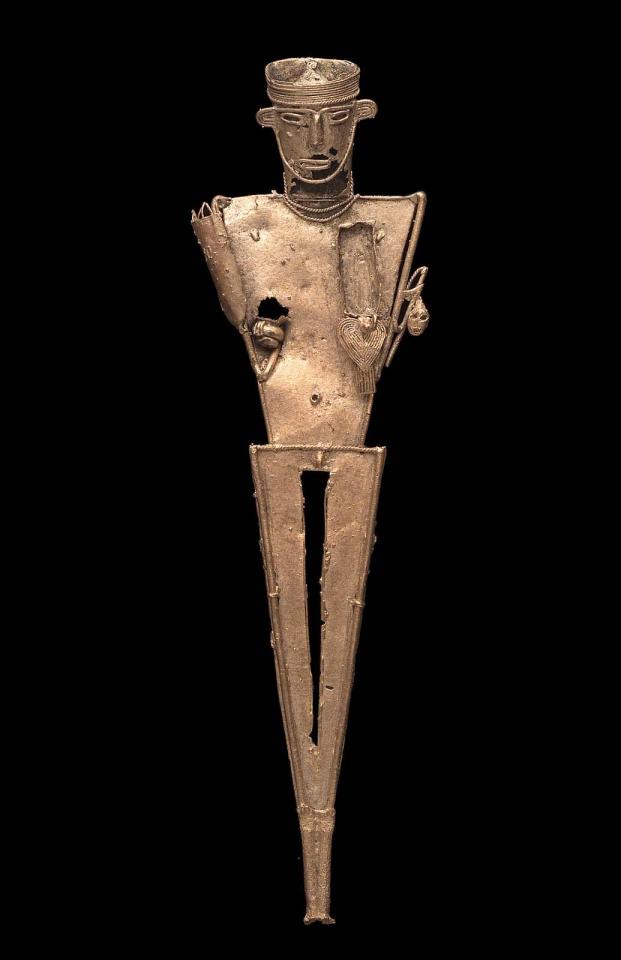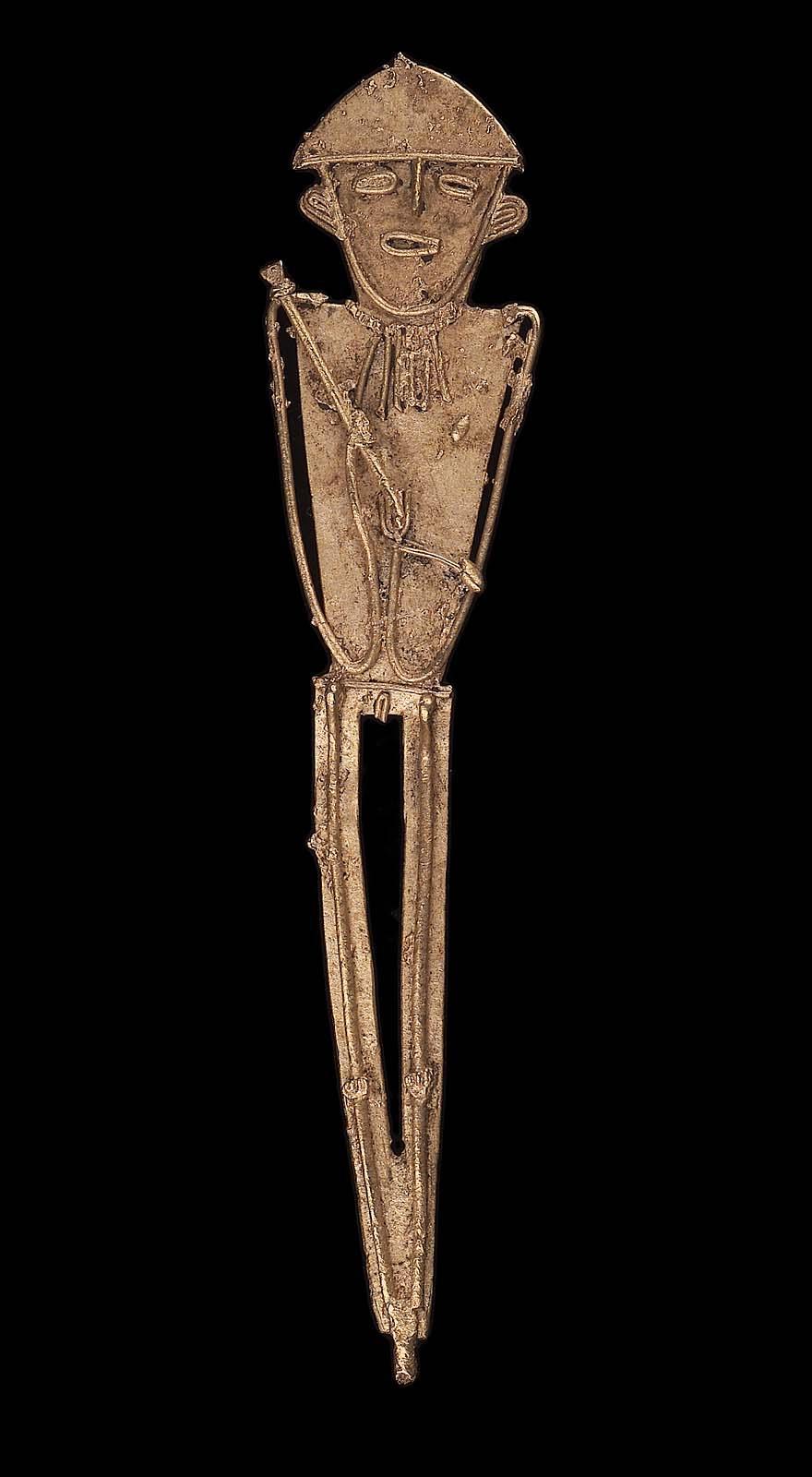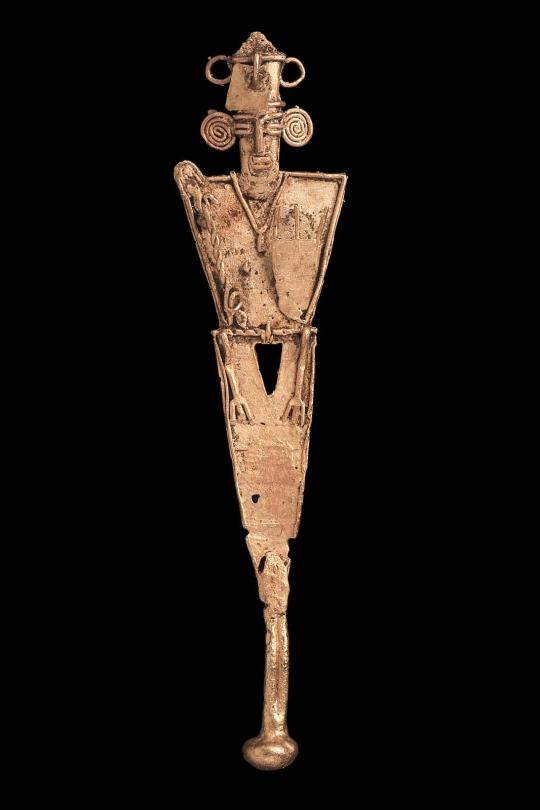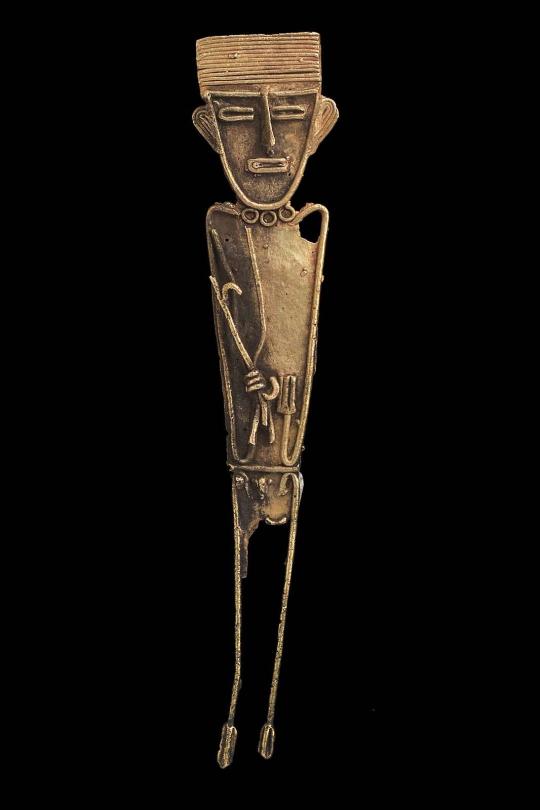#male effigy cache figure
Text




~ Male Effigy Cache Figure.
Culture: Muisca
Date: A.D. 1100–1550
Place of Origin: Departments of Cundinamarca & Boyacá, Colombia
Medium: Gold and copper alloy
#history#museum#archeology#archaeology#12th century#16th century#muisca#colombian#colombia#south america#Cundinamarca#boyaca#male effigy cache figure#male effigy#effigy#a.d. 1100#a.d. 1550
400 notes
·
View notes
Photo

Ritual Cache, Salado, 1300, Art Institute of Chicago: Arts of the Americas
Discovered wrapped and hidden in a remote, dry cave, this cache of ritual figures comes from the Salado culture, which flourished in the mountains of southwestern New Mexico and southeastern Arizona between the fourteenth and fifteenth centuries. Brilliantly colored and adorned with flicker feathers and dyed cotton string, these effigies once formed an altar as agents for communion with the life-giving spirits of the earth and sky. The large male figure, with his feather necklace and bold black-and-turquoise zigzag pattern, features sky symbolism. The smaller, female figure is a more self-contained form, probably corresponding to the earth. Her ocher color likely refers to maize and pollen, symbols of sustenance and fertility. The accompanying figures are a mountain lion (the chief predator in the region) and two serpents (carved from cottonwood roots), representing agents of communication with the earth and the seasonal cycle of fertility. Curved wooden throwing sticks for rabbit hunting complete the ensemble. Testimony to the antiquity and endurance of the worship of earth and sky and to the spiritual bonds between people and animals, these objects bear close resemblance to ritual figures and implements still used today among the diverse Pueblo peoples. Major Acquisitions Centennial Endowment
Size: Male figure: h. 64 cm (25 1/4 in.); female figure: h. 36 cm (14 3/16 in.)
Medium: Wood, stone, plant fibers, cotton, feathers, hide, and pigment
https://www.artic.edu/artworks/55249/
10 notes
·
View notes
Photo

Male effigy cache figure
Muisca
A.D. 1100–1550
Place of Origin: Departments of Cundinamarca & Boyacá, Colombia
Three-dimensional seated male effigy figure with arms folded across his bent knees. Carbonized casting core material remains inside the figure.
MFA
146 notes
·
View notes
Photo

Ritual Cache from the Salado Culture (modern-day Arizona, United States) (14th century)
Discovered wrapped and hidden in a remote, dry cave, this cache of ritual figures comes from the Salado culture, which flourished in the mountains of southwestern New Mexico and southeastern Arizona between the fourteenth and fifteenth centuries. Brilliantly coloured and adorned with flicker feathers and dyed cotton string, these effigies once formed an altar as agents for communion with the life-giving spirits of the earth and sky.
The large male figure, with his feather necklace and bold black-and-turquoise zigzag pattern, features sky symbolism. The smaller, female figure is a more self-contained form, probably corresponding to the earth. Her ochre colour likely refers to maize and pollen, symbols of sustenance and fertility. The accompanying figures are a mountain lion (the chief predator in the region) and two serpents (carved from cottonwood roots), representing agents of communication with the earth and the seasonal cycle of fertility. Curved wooden throwing sticks for rabbit hunting complete the ensemble. Testimony to the antiquity and endurance of the worship of earth and sky and to the spiritual bonds between people and animals, these objects bear close resemblance to ritual figures and implements still used today among the diverse Pueblo peoples.
17 notes
·
View notes
Text
Why Prehistoric Venus Figurines Still Mystify Experts

Venus of Willendorf, c. 28,000–25,000 B.C. Image by Helmut Fohringer / AFP / Getty Images.
Ample hips, voluminous breasts, uncovered pudenda—these are the most discussed features of the Stone Age statuettes of women commonly known as Venus figures or fertility figures. Dating as far back as around 40,000 B.C.E., the prehistoric statues have been touted as some of the earliest-known examples of figurative art worldwide. Yet they’re shrouded in mystery, and their interpretation has been influenced by over a century of cultural projection.
Archeologists have read them as goddess effigies, fertility talismans, likenesses of revered mothers, and nourishment charms. Many historians have focused on their exaggerated curves, but fewer have highlighted the range of body types they depict. Better-known examples, like the famed Venus of Willendorf, are voluptuous, while other, lesser-known figurines are usually more slender and lithe. We may never know exactly why these figurines were forged and who they depict, but that hasn’t stopped scholars from hypothesizing.

Female fertility figure, 5000 B.C.–9th Century A.D. Courtesy of the Metropolitan Museum of A

Drawing of Venus impudique, 1907. Image via Wikimedia Commons.
The first modern discovery of a Paleolithic statuette took place in 1864, thanks to a nobleman and amateur archeologist by the name of Paul Hurault, the 8th Marquis de Vibraye. While rooting around in the dig site of Laugerie-Basse in the Dordogne region of southwestern France, Hurault unearthed a 3-inch-tall ivory object. Though headless and armless, the figure retained a pronounced chest and clearly articulated vulva, boldly confirming it as female. Hurault, with satirical flair, named her Venus Impudique, or “immodest Venus,” a playful inversion of the classical Greek statue typology Venus pudica, in which a female figure modestly covers her genitals with a hand or cloth. By contrast, the Paleolithic figure seemed to take no pains to hide her sexuality.
Hurault didn’t know it then, but over 200 similar figurines from the Upper Paleolithic era would be unearthed across Europe and Asia, from France to Siberia, over the next century and a half. He not only launched this rash of discoveries, but also the tradition of calling the statuettes “Venuses.” It was a somewhat misleading name, given that the term originated in ancient Greece, tens of thousands of years after the Paleolithic figurines were made, to describe the goddess of love, sex, and fertility.
Carved in an era before written language, there is no clear proof about what these figurines represent. The most accurate clues scholars have about what the statuettes portrayed and why lie in the formal qualities of the figures themselves. Nearly all of them are petite—several inches long and diminutive enough to hold in a hand or string onto a cord (some even contain carved loops, seemingly for this purpose). The people who forged them led a nomadic life and some scholars conjecture that they intentionally made the figures small and light for easy transport. This hypothesis points to the personal value of the figurines and their possible devotional use. In this reading, the statuettes weren’t objects to be discarded, but ferried with their makers—held or strung close to bodies as they roamed from place to place.

Venus of Urbino, 1538.
Titian
Uffizi Gallery, Florence
Gender serves as another common thread across the Paleolithic figurines. Most are overtly female, and according to many scholars, even the ambiguous examples contain female attributes. While historians acknowledge that male figurines from this period could still surface, it seems that women were being depicted far more often. But why? What was their use? According to archeologist Nicholas J. Conard, one explanation rises above the rest: “Their clearly depicted sexual attributes,” he wrote in a 2009 issue of Nature, “suggest that they are a direct or indirect expression of fertility.”
Conard made this claim, which many other archeologists and historians have also espoused, in an article announcing his discovery of the oldest-known Paleolithic female figurine, dating between 40,000 and 35,000 B.C.E. (Other statuettes fall closer between 30,000 and 20,000 B.C.E.) In 2008, he and his team excavated six tiny pieces of mammoth ivory from the Hohle Fels cave in southwestern Germany. But it was only upon discovering the largest fragment—a lumpy, bulbous form—that “the importance of the discovery became apparent.” It was the majority of a torso: the linchpin of a female figure whose large breasts, rotund belly, and prodigious vulva take center stage. By comparison, her arms and legs appear slight, and in place of a head stands a carved ring (perhaps for original use as a pendant). Conrad put his interpretation bluntly: “Head and legs don’t matter. This is about sex, reproduction,” he told Smithsonian Magazine in 2012.

Venus of Hohle Fels, 35,000–40,000 B.C. Image via Wikimedia Commons.

Venus of Dolní Věstonice, 29,000–25,000 B.C. Image via Wikimedia Commons.
These proportions, in which areas of the body associated with reproduction (vulvas, breasts, hips, bellies) stand out, are typical of many Venus figurines. The Venus of Willendorf, which dates to around 25,000 years ago and was discovered in 1908, cuts a similar figure. The statuette’s pendulous breasts rest on a plump stomach, under which abundant hips and a pronounced vulva emerge. In comparison to the Hohle Fels Venus, Willendorf’s arms are even smaller and less defined, and while she has a head, its features seem intentionally obscured by a carved pattern resembling a woven hat or plaited hair.
But not all Paleolithic statuettes are so ample, nor their sexual organs as prominent. Some are slender or elongated; others adorned with crosshatching or other marks that might reference clothing. The figurines’ forms and features fluctuate, perhaps suggesting a breadth of models, aesthetic ideals, or uses. Conrad may be convinced that the statuettes represent fertility, but other scholars have made convincing arguments for their function as goddess figures, religious or shamanistic objects, or symbols of a matriarchal social organization.
The possibilities for interpretation seem endless, but as the archaeologist Olga Soffer has suggested, there should be limitations. Soffer warned against analyzing the figurines in terms of “18th-century Western European art.” While the misleading moniker “Venus” seems to have stuck, legions of archeologists and historians continue to reinterpret the cache of these statuettes, pushing them beyond narrow labels.
from Artsy News
0 notes
Photo

Ritual Cache, Salado, 1300, Art Institute of Chicago: Arts of the Americas
Discovered wrapped and hidden in a remote, dry cave, this cache of ritual figures comes from the Salado culture, which flourished in the mountains of southwestern New Mexico and southeastern Arizona between the fourteenth and fifteenth centuries. Brilliantly colored and adorned with flicker feathers and dyed cotton string, these effigies once formed an altar as agents for communion with the life-giving spirits of the earth and sky. The large male figure, with his feather necklace and bold black-and-turquoise zigzag pattern, features sky symbolism. The smaller, female figure is a more self-contained form, probably corresponding to the earth. Her ocher color likely refers to maize and pollen, symbols of sustenance and fertility. The accompanying figures are a mountain lion (the chief predator in the region) and two serpents (carved from cottonwood roots), representing agents of communication with the earth and the seasonal cycle of fertility. Curved wooden throwing sticks for rabbit hunting complete the ensemble. Testimony to the antiquity and endurance of the worship of earth and sky and to the spiritual bonds between people and animals, these objects bear close resemblance to ritual figures and implements still used today among the diverse Pueblo peoples. Major Acquisitions Centennial Endowment
Size: Male figure: h. 64 cm (25 1/4 in.); female figure: h. 36 cm (14 3/16 in.)
Medium: Wood, stone, plant fibers, cotton, feathers, hide, and pigment
https://www.artic.edu/artworks/55249/
5 notes
·
View notes
Photo

Ritual Cache, Salado, 1300, Art Institute of Chicago: Arts of the Americas
Discovered wrapped and hidden in a remote, dry cave, this cache of ritual figures comes from the Salado culture, which flourished in the mountains of southwestern New Mexico and southeastern Arizona between the fourteenth and fifteenth centuries. Brilliantly colored and adorned with flicker feathers and dyed cotton string, these effigies once formed an altar as agents for communion with the life-giving spirits of the earth and sky. The large male figure, with his feather necklace and bold black-and-turquoise zigzag pattern, features sky symbolism. The smaller, female figure is a more self-contained form, probably corresponding to the earth. Her ocher color likely refers to maize and pollen, symbols of sustenance and fertility. The accompanying figures are a mountain lion (the chief predator in the region) and two serpents (carved from cottonwood roots), representing agents of communication with the earth and the seasonal cycle of fertility. Curved wooden throwing sticks for rabbit hunting complete the ensemble. Testimony to the antiquity and endurance of the worship of earth and sky and to the spiritual bonds between people and animals, these objects bear close resemblance to ritual figures and implements still used today among the diverse Pueblo peoples. Major Acquisitions Centennial Endowment
Size: Male figure: h. 64 cm (25 1/4 in.); female figure: h. 36 cm (14 3/16 in.)
Medium: Wood, stone, plant fibers, cotton, feathers, hide, and pigment
https://www.artic.edu/artworks/55249/
9 notes
·
View notes
Photo

Ritual Cache, Salado, 1300, Art Institute of Chicago: Arts of the Americas
Discovered wrapped and hidden in a remote, dry cave, this cache of ritual figures comes from the Salado culture, which flourished in the mountains of southwestern New Mexico and southeastern Arizona between the fourteenth and fifteenth centuries. Brilliantly colored and adorned with flicker feathers and dyed cotton string, these effigies once formed an altar as agents for communion with the life-giving spirits of the earth and sky. The large male figure, with his feather necklace and bold black-and-turquoise zigzag pattern, features sky symbolism. The smaller, female figure is a more self-contained form, probably corresponding to the earth. Her ocher color likely refers to maize and pollen, symbols of sustenance and fertility. The accompanying figures are a mountain lion (the chief predator in the region) and two serpents (carved from cottonwood roots), representing agents of communication with the earth and the seasonal cycle of fertility. Curved wooden throwing sticks for rabbit hunting complete the ensemble. Testimony to the antiquity and endurance of the worship of earth and sky and to the spiritual bonds between people and animals, these objects bear close resemblance to ritual figures and implements still used today among the diverse Pueblo peoples. Major Acquisitions Centennial Endowment
Size: Male figure: h. 64 cm (25 1/4 in.); female figure: h. 36 cm (14 3/16 in.)
Medium: Wood, stone, plant fibers, cotton, feathers, hide, and pigment
https://www.artic.edu/artworks/55249/
3 notes
·
View notes
Photo

Ritual Cache, Salado, 1300, Art Institute of Chicago: Arts of the Americas
Discovered wrapped and hidden in a remote, dry cave, this cache of ritual figures comes from the Salado culture, which flourished in the mountains of southwestern New Mexico and southeastern Arizona between the fourteenth and fifteenth centuries. Brilliantly colored and adorned with flicker feathers and dyed cotton string, these effigies once formed an altar as agents for communion with the life-giving spirits of the earth and sky. The large male figure, with his feather necklace and bold black-and-turquoise zigzag pattern, features sky symbolism. The smaller, female figure is a more self-contained form, probably corresponding to the earth. Her ocher color likely refers to maize and pollen, symbols of sustenance and fertility. The accompanying figures are a mountain lion (the chief predator in the region) and two serpents (carved from cottonwood roots), representing agents of communication with the earth and the seasonal cycle of fertility. Curved wooden throwing sticks for rabbit hunting complete the ensemble. Testimony to the antiquity and endurance of the worship of earth and sky and to the spiritual bonds between people and animals, these objects bear close resemblance to ritual figures and implements still used today among the diverse Pueblo peoples. Major Acquisitions Centennial Endowment
Size: Male figure: h. 64 cm (25 1/4 in.); female figure: h. 36 cm (14 3/16 in.)
Medium: Wood, stone, plant fibers, cotton, feathers, hide, and pigment
https://www.artic.edu/artworks/55249/
1 note
·
View note
Photo

Male effigy cache figure
Muisca
A.D. 1100–1550
Place of Origin: Departments of Cundinamarca & Boyacá, Colombia
Three-dimensional tunjo male effigy figure. He holds what appear to be a spear thrower and darts in his right hand. His elaborate body adornments include pendant ornaments and a tall headdress with six rings to which are attached adorning flanges. His ribs are indicated by diagonal lines, and two wide bands cross his chest.
MFA
37 notes
·
View notes
Photo


Seated human effigy
Maya
Classic Period, A.D. 350–600
Object Place: Department of Tiquisate, Guatemala
Human male figure seated on a square base embellished with Teotihuacan-style modeled flowers, sea shells and feathered mirrors. The figure originally wore a tall headdress, most of which has broken off. He wears a long cape and wide loincloth. In his left hand is a small dish, and a larger object is held in his right hand although most of this object has broken away. The figure is likely the lid of a cache vessel, the lower section of which did not survive.
MFA
42 notes
·
View notes
Photo


Human effigy cache vessel (incense burner)
Maya
Postclassic Period, A.D. 1250–1500
Object Place: Belize or southeastern Mexico
A large, circular container or urn with tall annular base is embellished with a modeled rendering of a standing male figure. He wears a long tunic and loincloth, a wide collar with three disk ornaments and a large pendant hanging below the collar, and sandals with tall backs and tie-ends at the front. He also wears large, circular earflares and a curvilinear adornment on his nose bridge. His headdress has side flaps that extend over his shoulders and onto his back, the front of which is modeled in the form of a zoomorphic head with pointed snout. Two vertical lines of spikes on the sides of the container resemble the typical decorated flanges found on burial urns from the southern Guatemalan highlands. The urn contains approximately 50 small pieces (average size 1.5 x 3 cm) of desiccated copal incense covered with the same post-fire white paint as that on the vessel’s exterior surface.
This male figure wears a tunic and loincloth and an unusual head wrap, with flaps. The spikes imitate the bark of the “ceiba,” the tallest tree in the forest and the model for the mythic world tree. The urn contains small pieces of desiccated copal (pine tree resin) incense. This censer probably was found in a ceremonial cave; such large, ceramic sculptures rarely survived the challenging tropical environment or the religious zeal of Spanish invaders.
MFA
68 notes
·
View notes
Photo

Male effigy cache figure
Muisca
1100–1550
Place of Origin: Departments of Cundinamarca & Boyacá, Colombia
Male figure with “long rectangular body and short legs, holding a tuber or maize ear in the right hand, and a small cup to the chest, a staff at his side with a bird perched atop and leaning towards the warrior’s face, wearing a collar of long tublular beads and cord necklace, one dangle earring, the rectangular headdress with loops at the four corners for suspension of ornaments, one circular dangle remaining.” [from Sotheby’s catalogue, description text]
MFA
49 notes
·
View notes